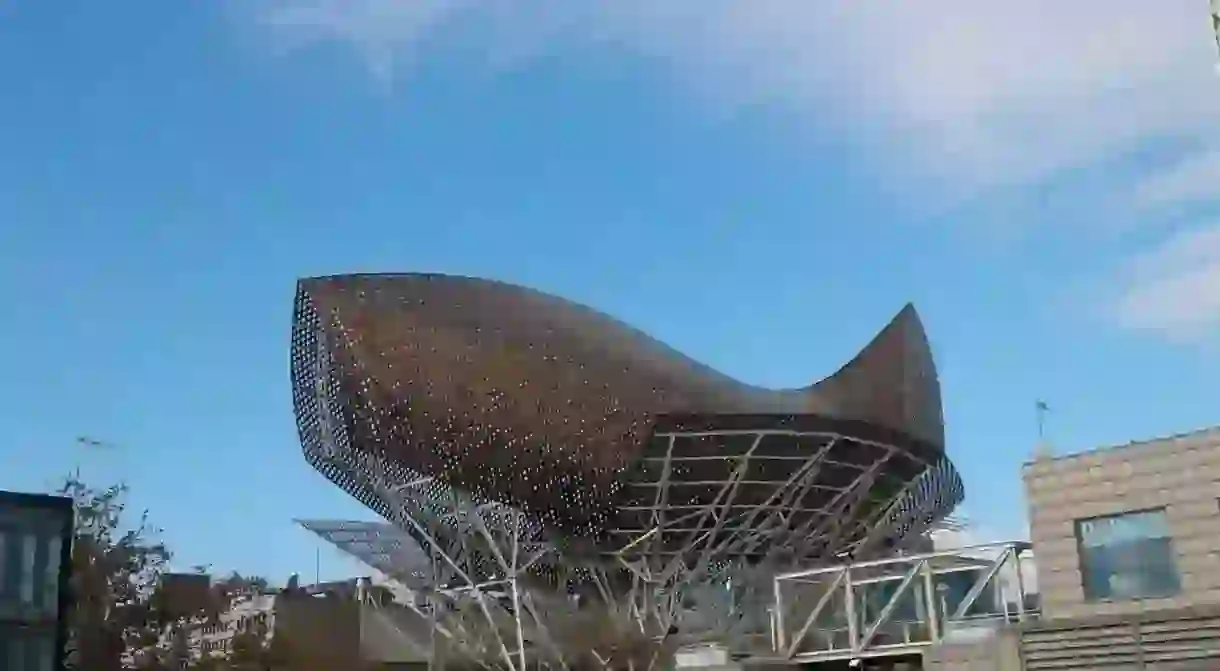Animal Street Sculptures – a Walk Through the Jungle in Barcelona

Welcome to Barcelona, a city for animal lovers. Let’s start our tour from the beach: one of the city’s landmarks. A stroll along the seafront and a swim during the hot days of the summer is a must.
Near the Port Olimpic, on Passeig Maritim, a large golden fish dominates the view. Peix d’Or is a bronzed-steel, giant sculpture created by Frank Gehry for the 1992 Barcelona Olympics and it has rapidly become one of the city’s icons.

If you look down, just below the fish, you will see a glass column containing sand and painted ants. Its interpretation is open, but one could be that it represents the mass of people living on the beach like ants in their nests.

A bit further along, towards Playa de la Barceloneta, just past the Port Vell (Passeig de Colom) another sea inhabitant is waiting for us: Gamba de Mariscal, a big cartoon lobster made by a Spanish artist Javier Mariscal in 1988. He is famous for having designed the Olympic mascot (a sheep dog called Cobi).
Continuing on the Passeig you arrive on the renowned pedestrian street La Rambla, one of the busiest places in town, always packed with foreigners, students, locals and street artists. Among this crowd, you will bump into a fat cat: a sculpture by Colombian artist Fernando Botero. This chunky bronze sculpture, purchased in 1987 by the City Council, found its permanent location 16 years later, in 2003, and since then El Gato has become a favorite meeting place and photo op.

On the left hand side of La Rambla, you enter El Raval, a neighborhood that has changed significantly in recent years and today houses museums and contemporary art spaces – historically, it was considered very dangerous for its crime and prostitution.
Just behind the Barcelona Museum of Contemporary Art, on a hidden wall, there is a painting by Keith Haring: a 30-meter (98-foot) long mural, which was transferred onto this wall in mid 90s. This work, entitled Todos Juntos Podemos Parar el SIDA, depicts in red paint – the color of blood – the fight against AIDS: a big red snake is the protagonist, gripping a syringe while people try to escape this global plague.

From Haring’s mural, look upwards toward the sky you will see on the wall of a high building a group of cats depicted in different poses by the city’s graffiti artists.
Beside Plaça d’Espanya, below the Pavilions and Parc de Montjuïc, a colorful large sculpture by Joan Miro stands in the middle of a park named after the artist. Dona i Ocell is a 22m-high figure (72 ft.) of a woman and a bird on top. It was made in 1983 by Joan Miro’ using a unique Catalan technique called trencadis: a type of mosaic , common in Catalan modernism, using broken tile shards – this same technique was used by Antoni Gaudi for his architecture in the city.
Not far from Miro’s sculpture – further north – is Parc Güell, a large and famous park that Antoni Gaudi designed for Guell family in the 20th century. At the entrance of the park is El Drac, a multicolored fountain in the form of a lizard to welcome you.

If you like this walk through the city’s safari, you can continue your tour in Parc Güell where you will find many other animal creatures. In addition, in Parc de la Ciutadella, the most popular park with locals, you will find various fairy and mythological figures. On the way, two sculptures by Josep Granyer that decorate the Rambla de Catalunya are: El Brau Pensador and La Jirafa Coqueta, bronze sculptures of a bull and a giraffe in playful poses, from the 70s.













